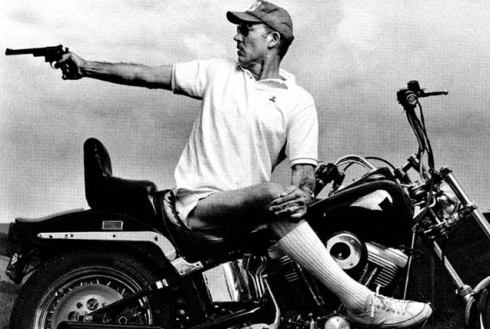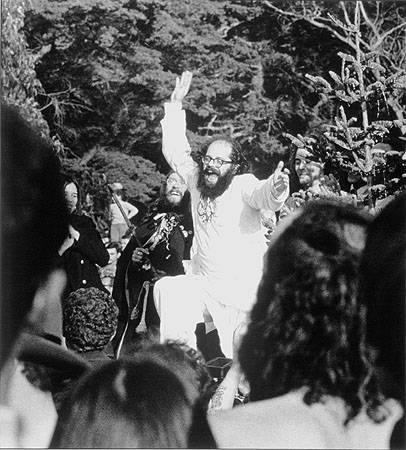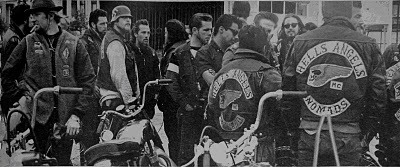WARNING: This post contains descriptions of alleged sexual violence.
For the last six years or so, one party has been haunting me. It wasn’t any soiree I’d attended—this party took place on Saturday August 7, 1965 at Ken Kesey’s LSD-laced ranch in La Honda, California. It was a fete that epitomized the West Coast psychedelic movement’s embrace of drugs, music, and above all, the outlaw lifestyle. What made this party special wasn’t its mix of intellectuals—poet Allen Ginsberg and Harvard psychology professor Richard Alpert (aka Baba Ram Dass) among them—and countercultural icons such as Hunter S. Thompson and Neal Cassady; it was the 15-foot-long, red white and blue sign strung up outside the ranch: THE MERRY PRANKSTERS WELCOME THE HELL’S ANGELS.
I’ve come across depictions of this party in so many places that it’s practically a historic event. Hunter Thompson described it in Hell’s Angels: A Strange and Terrible Saga of the Outlaw Motorcycle Gangs, Tom Wolfe gave it a giddy portrayal in The Electric Kool-Aid Acid Test, and even Ginsberg immortalized it in a poem. Most recently, Seth Rosenfeld gave it an entirely new context in Subversives: The FBI’s War on Student Radicals, and Reagan’s Rise to Power (check out an excellent analysis of this book apropos to today’s surveillance fiasco on Sammy Scoops’ blog).
Rosenfeld points out that this party—during which the tie-dyed psychedelic community and the swastika-sporting motorcycle gang effectively coexisted without any fatalities—came only two months before the Angels gave an unequivocal beatdown to a members of the Vietnam Day Committee (VDC) as they attempted to peacefully march into Oakland in protest of the war. The parade was led by “a chanting, cymbal-clanging Ginsberg,” but all the ohms in the world weren’t going to stop the Angels, whom the FBI allegedly allowed to commence attacking protesters before police intervened. Rosenfeld reports that it took a subsequent LSD-fueled meeting between Ginsberg, Kesey, and Hell’s Angels leader Sonny Barger to get the Angels off the VDC’s back.
The Angels’ pro-Vietnam stance may seem at odds with the group’s anti-establishment ethos and self-exiling behavior, but as Thompson puts it:
Their political views are limited to the same kind of retrograde patriotism that motivates the John Birch Society, the Ku Klux Klan and the American Nazi Party. They are blind to the irony of their role … knight errants of a faith from which they have already been excommunicated. The Angels will be among the first to be locked up or croaked if the politicians they think they agree with ever come to power.
Given this, and the subsequent tensions with the VDC, it seems odd that the Hell’s Angels/Merry Pranksters party at La Honda is portrayed as such a celebratory event—particularly in The Electric Kool-Aid Acid Test. Coming across the party in Subversives inspired me to take a closer look back at other accounts of the event. One aspect stood out like a sore thumb: the portrayals (or nonportrayals) of an alleged gang rape that took place at the party.
The incident is absent from Rosenfeld’s account (it is arguably irrelevant to his book), but also from Ginsberg’s poem, which ends on this deceptively serene note: “children sleeping softly in their bedroom bunks. / And 4 police cars parked outside the painted / gate, red lights revolving in the leaves.” But Thompson’s Hell’s Angels and Wolfe’s Electric Kool-Aid both portray the incident, and in such stark similarity that it seems apparent that Wolfe lifted Thompson’s notes (I assume with permission—there’s no indication that Wolfe was even at the party and Thompson certainly was).
Thompson chooses to describe the incident four chapters before even mentioning the Prankster party, in a chapter devoted to the concept of rape in the world of the Hell’s Angels. However, Thompson’s incident most certainly happened at the Prankster party, as evidenced in chapter 17 of Hell’s Angels—“I keep a crumpled yellow note from that night […] Pretty girl about twenty-five lying on wooden floor […] red and white dress pushed up around her chest […] girl jerking and moaning, not fighting, clinging, seems drunk, incoherent, not knowing, drowning…” When compared with chapter 13 of Electric Kool Aid, which describes a girl with “her red and white dress pushed up around her chest,” the two stories are virtually identical, right down to the woman’s ex-husband getting in on the action, but only after the girl “asks him to kiss her.”
The incident is brushed off in Electric Kool Aid, with Wolfe writing “but that is her movie, it truly is, and we have gone with the flow.” Thompson, however, delves a bit deeper. “It was not a particularly sexual scene,” he writes, “The impression I had at the time was one of vengeance. The atmosphere in the room was harsh and brittle, almost hysterical.” Afterward, the girl “rested for a while and then wandered around the party in a blank sort of way and danced with several people.” She was later “taken back for another session.” After that, Thompson “saw her trying to dance with her ex-husband, but all she could do was hang on his neck and sway back and forth. She didn’t even seem to hear the music.”
“What would a jury make of that one?” Thompson wonders. In this day and age, it’s pretty clear what a jury would make of that one. But Thompson goes on to employ the logic as popular 50 years ago as it is today: “If the girl was raped why didn’t she protest or ask somebody for help?” He later goes on to answer his own question: “The girl had several chances to leave the party and call the police, but that was out of the question. Girls who get turned out at Hell’s Angels parties don’t think of police in terms of protection.” The police, as we know in all accounts, were amassed right outside the party, their red lights casting a psychedelic glow on the scene. At the end of the chapter, Thompson concludes that the Angels are rapists, though only in a more “obvious” way than the plundering capitalists of 20th-century America.

Still the definition of Bad Ass
image via magedesign.com
Of the two-day long party, Wolfe admits that “Everybody, Angels and Pranksters, had a righteous time and no heads were broken.” He again brings up the gang bang, but again asserts that “the girl was a volunteer. It was her movie.” He chalks the whole party up as a victory for Kesey, who had managed to turn La Honda into “an intellectual tourist attraction”—a place for intellectuals to come face to face with “real life,” a concept seemingly out of reach for the ivory tower crowd. It’s true that the Angels represented everything Kesey preached; they were authentically “out front,” spontaneous, anti-authoritarian, and most assuredly outlaws. In many ways, the Angels were the id of Kesey’s Prankster movement, and though taming them with free booze and LSD made for a neat party trick, there’s no denying that the men were quite dangerous.
The fact that the “only” violence that occurred at the party was of a sexual nature—in Thompson’s words, an act of “vengeance”—only underlines the problematic nature of Kesey’s psychedelic movement. At its core, the movement preached unrestrained self-indulgence within a (let’s face it) male-dominated hierarchy. Although Wolfe portrays Kesey’s mistress Mountain Girl as number one on the female Prankster hierarchy, she is still subservient to Kesey and eventually ends up pregnant and left behind during Kesey’s flight to Mexico. And though she imitates Kesey’s disarming charm in her bold dialogues with the Angels, we never get to hear her thoughts on the gang bang incident. Wolfe glosses over Thompson’s hesitations about the woman’s state of mind, and that’s that.
Wolfe also chooses not to address the tensions that arose between the Angels, the Pranksters, and the VDC just weeks later, but it’s clear that the Angels-Prankster synthesis had begun to decay just as soon as it came together. Even under Kesey’s “control,” the Angels were as wild and depraved as ever, dragging some of the Pranksters down with them. “One or two of the non-Angel guests finally joined in,” Thompson admits of the rape.
In hindsight, the Angels/Prankster party is memorable not just for its debauchery, amusingly incongruous cast of characters, or its sexual deviances. It can indeed be seen as a microcosm of an unsustainable social movement, one that marginalized and even silenced female voices in favor of reckless, hedonistic bravado.
And yet, it took an undeniable bravery to reach out to the Angels, a group known only for the unspeakable havoc they wreak wherever they go. The party represented a commendable crossing of socioeconomic boundaries, even if the results weren’t as idyllic as some would have believed. It was a unique social experiment, albeit one that foreshadowed the psychedelic movement’s downfall, if not the terror at Altamont. Many countercultural fanatics, myself included, would have given anything to be a fly on the wall at La Honda as Allen Ginsberg sang Hare krishna at a bunch of hulking Angels in full Nazi regalia. Still, I don’t think I’ll be inviting any motorcycle hoodlums to my next house party.

I might invite this guy, though.
Image via eskimo.com


I enjoyed it ! What should I print for grandma?
Sent from my iPhone
Mountain Girl says this was Cassady’s girlfriend. She was jealous that Ginsburg was there and was hooking up with Neal. Yes, this was revenge on Neal. She kept saying look, look what you make me do. Neal watched and started sucking a tailpipe of a motorcycle, saying do you want me to suck this? Ask MG, ask the Pranksters…it was VERY voluntary!
Thanks for taking the time to read my blog, and thanks very much for the information! That definitely adds a whole new layer of drama to the entire party!
I’m an admirer of your father’s work, and I ended up studying his time with the Pranksters while writing my senior thesis, which was centered partly around The Electric Kool-Aide Acid Test. I wonder if you would be interested in sharing your thoughts on my work, which I’ve posted to this blog (The essay itself begins here, while the portion on Electric Kool Aid begins here). Since I relied on Electric Kool Aid as the primary source for the timeline of events circa 1965-67, you may be in a position to help fill in the gaps and correct any factual inaccuracies.
I appreciate your interest!
Hi, I want to add some information to your blog entry. The incident you describe has been mentioned in the documentary “Gonzo” which is about Hunter S. Thompson. Hunter S. Thompson had always a tape recorder with him to keep notes. When he stopped by at this party he recorded what he saw on tape. Later he passed the tapes to Wolfe. In the documentary Wolfe himself is interviewed about this.
Hey, thanks for the info! I actually haven’t seen “Gonzo” but it’s been in my Netflix queue forever. I should definitely check it out.